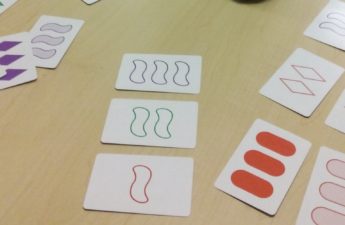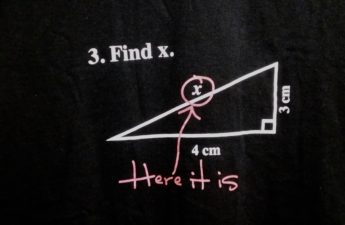Have you ever had trouble remembering how to “carry the one” or had difficulty understanding what it means to “borrow?” Do you pause when deciding which way to “move” a decimal or how many zeros to “add” to the end of a number?
Most people I talk to believe math is a {really, really large} set of rules and steps and facts that have to be memorized. We have trouble remembering everything so we spend time “learning” shortcuts that will save us time and make math “easier.” In reality, those little tricks are just one more thing we have to memorize and they undermine our understanding of the actual math so much that we end up believing we aren’t “math people.”
Spoiler Alert: You are a math person!
Truth is, we are all math people. We use math all the time and we don’t even realize it. {You even use Algebra, if you can believe it!}
If you don’t believe me, go check out this post on some of the ways you use math EVERY day!
So, why do we like using tricks that don’t even make any sense at all? Maybe we are afraid we won’t understand the math. Maybe we never had anyone explain a concept to us in a way that made sense. Maybe we were taught those tricks because our teacher didn’t understand the math either. Maybe we just like shortcuts.
Who knows?
The important thing is to be able to tell the difference between a trick and “real” math. For example, what do you do when you multiply a number by 100? My guess is that you answered something like, “You just add two zeros to the end of the number.” But why? And does that work for EVERY number? This trick really takes away from an important concept in our base 10 number system…how place value works and the relationships between numbers. When you just “add” two zeros to the end of a number, you lose the understanding of this relationship. We can’t just magically change the value of a number. We have to understand the relationships and know why the value changes.
Let’s take a look at what happens. Put these in your calculator if you need to, to verify the products.
4 x 10 = (4 groups of 10, or 10 + 10 + 10 + 10) = 40
40 x 10 = 4 x 10 x 10 = 400
400 x 10 = 4 x 10 x 10 x 10 = 4000
It looks like we are “adding” a zero to the end of the number each time, but what we are really doing is finding a number that is 10 times as large as the number we started with.
Sure, when you multiply a whole number by 100 (x 10 x 10) it ends up with two extra zeros at the end. But relying on this trick to get us through will eventually get us in trouble. What if the number is a decimal? Again, use a calculator to verify if you need to.
3.456 x 10 = 34.56
34.5 x 10 = 345.6
345.6 x 10 = 3456
Do you see any zeros at the ends of those numbers? Nope. Not a one. If our only “understanding” of multiplying by a power of 10 is that we “add” a certain number of zeros to the end of a number, then we would be in big trouble right now. We would think that 3.456 x 10 = 3.45600. {It doesn’t. In fact, 3.456 and 3.45600 have the exact same value!}
Now, you may have answered earlier that to multiply by 100 means that you “move the decimal 2 times.” But why does it look like that? The underlying concept is that each time you multiply by 10, you get a number that is 10 times the original number. Ten ones is 10. Ten tens is 100. Ten hundreds is 1000. Ten quarters (0.25) is 2.5. Ten two and a halves is 25. Ten twenty-fives is 250. Sure looks like the decimal is “moving.”
So, what’s my point here? Let’s focus on the real math instead of teaching our children tricks. Those tricks might seem to make math easier right now, but there will come a time in the future when the lack of true understanding negatively impacts your child. There will be plenty of time for our children to develop their own set of shortcuts based on their own understanding and recognition of the patterns of math. For now, focus on making sure they really understand how the math works.
There is an awesome online community of math educators, called The Math Twitter Blogosphere (MTBoS), who worked together to create a great resource for everyone. It’s a book called Nix the Tricks and it is FULL of all those tricks you learned as a student and a bunch that I never even knew existed! (That whole decimal moving and zero adding thing is just one example!) I really like this book because it explains the {real} math behind many of those tricks you learned to get through math class. The best part is that it’s a FREE download at nixthetricks.com.
What are some of the tricks you learned that you never really understood? Did you ever run into problems in math class because you tried to use a trick in a wrong situation or because you couldn’t remember how it worked? I’d love to hear your experiences in the comments!
Thanks for visiting!




I love this! I was 37 and taking math 101 at local college and had a great teacher for the first time in my life. I finally understood place value, fractions, division. Wow! Life changing! I became a teacher and hope I helped my students learned these concepts!
So many of my students at the college level had no idea how numbers really work. Given that a large percentage of people who never finish a degree program drop out because of difficulty with math, it is so very important that we make sure to teach them correct ways of thinking! You are a testament to how a great math teacher can change the future for so many. Thank you so much for sharing here and for visiting!
I love this! I teach chemistry and I’m glad to hear you teaching kids how to understand quantitative concepts now 🙂
Fluency with quantities (and UNITS!) is so important in chemistry! I hope you see students who have a good foundation of number concepts! Thanks for visiting!
I love this post! Explaining how the math works instead of using tricks or cutesy acronyms is so important. I know they’ve got it when my fifth graders can do the explaining to each other or can write an explanation for someone. Thanks for the link to Nix the Tricks!
My current middle grades students get so frustrated with me when I won’t let them explain order of operations with PEMDAS or when I won’t accept a decimal answer when they can’t explain how much it represents (like .3 repeating). I don’t even let them say “point” unless we are talking about graphs…that really gets them! Thank you so much for your feedback and for visiting!